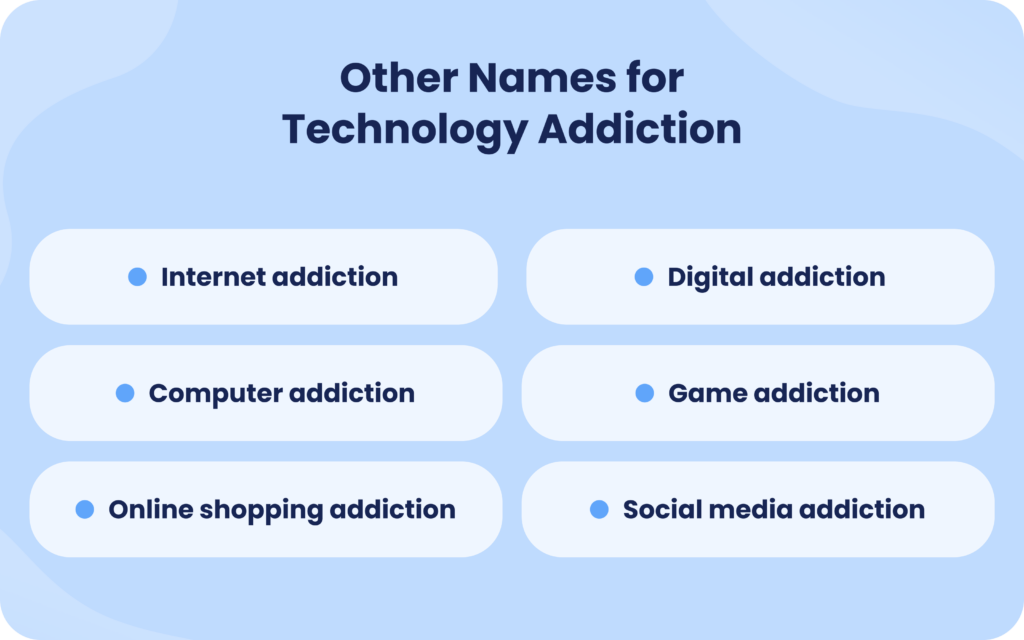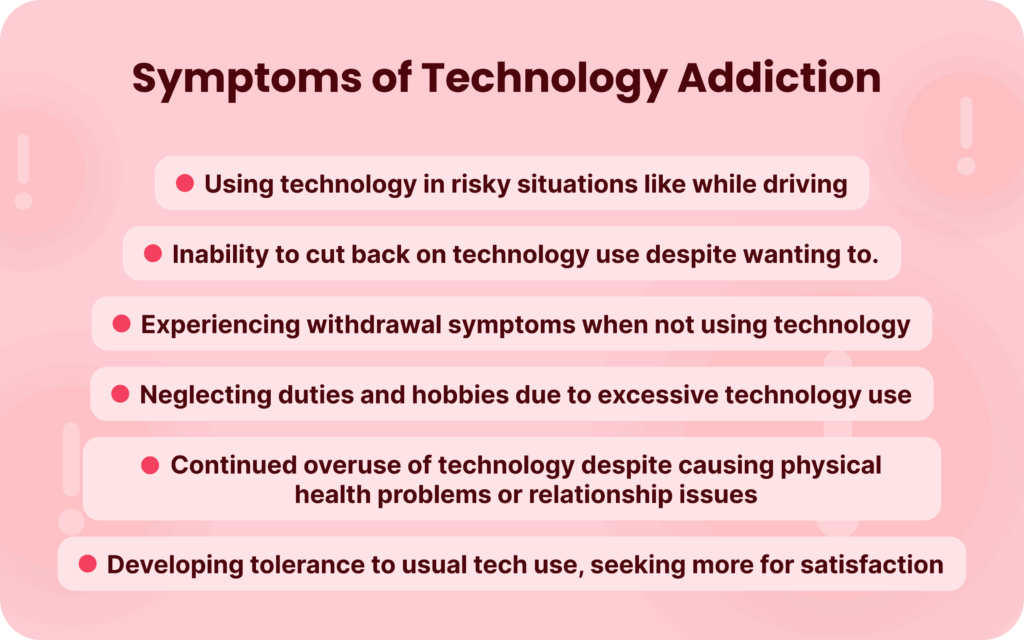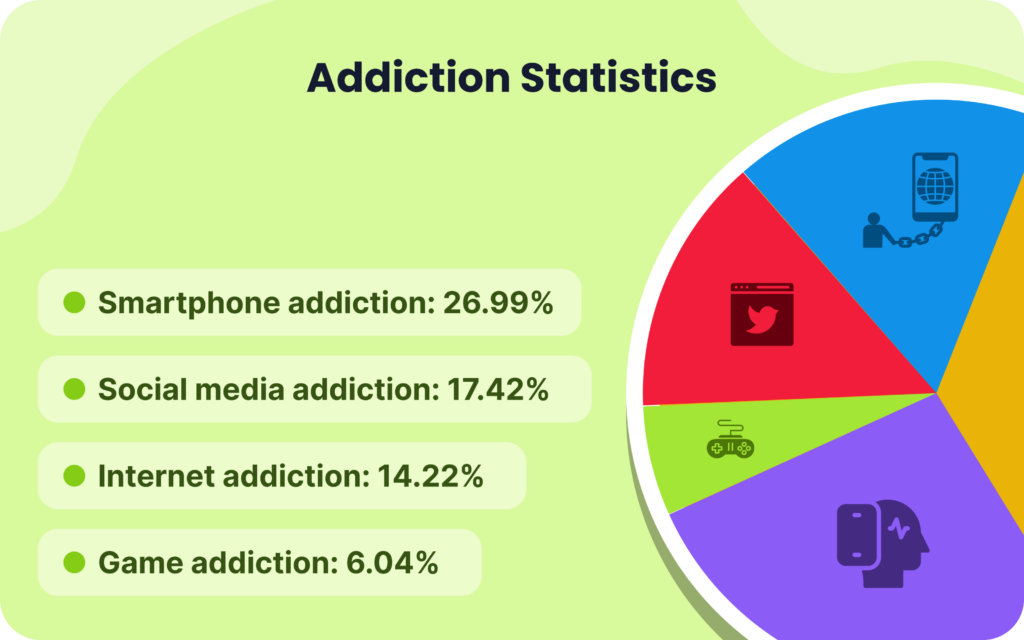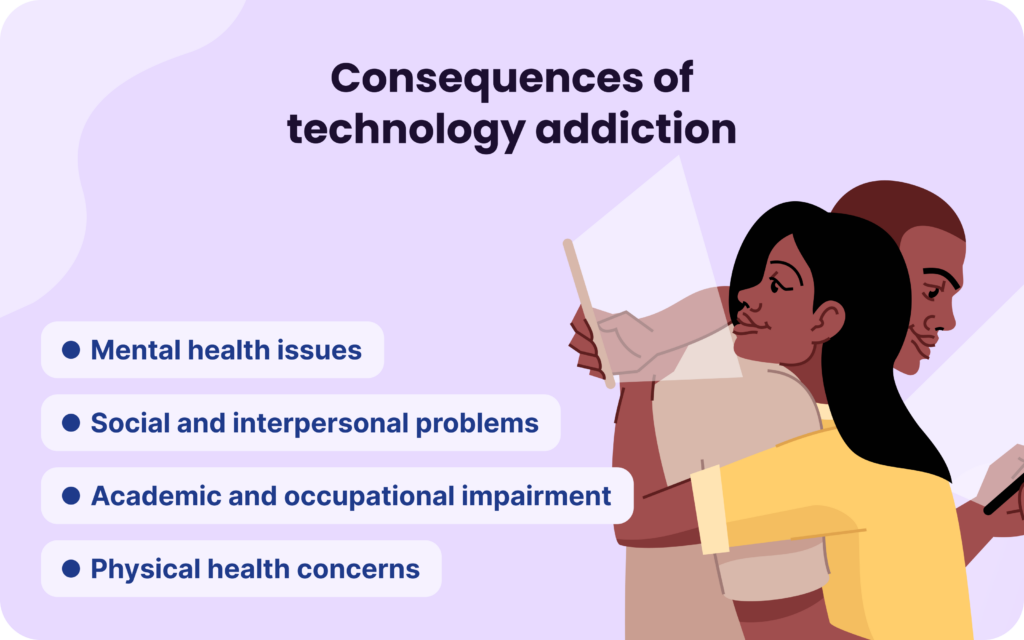What is technology addiction?
Technology is deeply ingrained in our daily lives, so you might think that excessive use is normal. There are so many technology options available, all offering ways to engage and entertain ourselves. It’s easy to get lost in the digital world, spending hours per day online.
In some cases, this isn’t so bad. Technology allows us to connect with others, enjoy our free time, and even do our jobs better. The average American probably reaps many benefits from technology.

Technology does offer numerous benefits; however, the line between moderate use and excessive reliance on technology is a little blurry. When technology use becomes excessive and interferes with other aspects of life, a person may show signs of technology addiction. This can also be called internet addiction or digital addiction.
So, how do you know if technology addiction has become a problem? Below, we’ll spell out the signs of digital addiction, as well as actionable steps for managing it.
Defining Technology Addiction
Technology addiction is described as a compulsive and excessive dependence on technology, leading to negative consequences in someone’s life. It involves an inability to control one’s use of technology, despite being aware that it’s causing problems.
Tech addiction can appear in several different ways. Common sources include smartphones, computers, video games, social media platforms, and online gambling websites. These technologies offer instant gratification, constant stimulation, and opportunities for social connection, making them a breeding ground for addictive behaviors.
Maybe you know the signs of technology addiction all too well. Perhaps you have a friend who never has their homework done, because they’ve been up all night playing video games. Or maybe you are so distracted by social media, that you’re beginning to lose your friendships because of neglect. These are both examples of potential digital addiction.
Other Names for Technology Addiction

The term technology addiction is rather broad. It refers to problems related to a range of different technologies, such as social media or video games. So, you might hear people using other terms to talk about technology addiction:
- Internet addiction
- Digital addiction
- Computer addiction
- Game addiction
- Social media addiction
- Online shopping addiction
The various forms of technology addiction differ in the subject of the addiction. Digital addiction and internet addiction are pretty broad terms. On the other hand, online shopping and social media are specific forms of tech addiction.
Can Technology Really Become an Addiction?
When you think of addiction, you probably imagine someone who struggles with drugs or alcohol. Given this fact, you might not be convinced that technology addiction is actually a possibility. In reality, it is quite possible for technology and internet use to rise to the level of an addiction.
The Diagnostic and Statistical Manual of Mental Disorders (DSM) is the tool that mental health clinicians use to make diagnoses. It does not specifically list technology addiction as a diagnosable condition.
Gambling disorder, which is probably the most closely related to technology addiction, is included in the DSM as a diagnosis. This condition is listed in the same chapter as the other addictions, which are formally labeled as substance use disorders.
The symptoms seen in substance use disorders and gambling disorders can appear in individuals who become overly dependent upon technology. Rather than symptoms relating to gambling or an addictive substance, they involve some form of technology. This could be video games, social media, or use of a smartphone.
Various digital technologies can lead to compulsive technology use that interferes with daily life. As a result, the DSM has recommended internet gaming disorder as a condition requiring further study.
While not all technology addiction relates to internet gaming, addiction to online video games is a form of technology addiction. The inclusion of this disorder as a condition requiring further study provides additional support for the reality of technology addiction.
When a person uses technology excessively, and they experience consequences related to their use, this is evidence of addiction. If you’re struggling, you may find that you can’t cut down on technology use. This is the case, even if it’s interfering with your relationships or mental health. In this way, tech addiction has some features in common with substance abuse.
Signs and Symptoms of Technology Addiction

The signs and symptoms of technology addiction align with what is seen with other addictions. These signs include:
- Excessive amounts of technology use.
- Being unable to reduce technology use.
- Continued overuse of technology, even when it causes physical health problems or interferes with relationships. For example, you might continue to spend hours a day playing online games, even if it causes arguments with your parents.
- Using technology in cases where it is dangerous, such as monitoring social media while driving.
- Developing a tolerance, so that the usual level of technology use no longer brings the same satisfaction.
- Showing withdrawal symptoms when not using technology, such as becoming agitated or anxious.
- Spending a significant amount of time using technology, so it interferes with other areas of life.
- Being unable to fulfill duties at work or with family due to technology use.
- Giving up other hobbies and activities in favor of technology use.
- Experiencing an intense desire to use technology when you’re unable to do so, similar to what might be described as a craving.
How Common is Technology Addiction?
It’s difficult to determine how many people struggle with technology addiction, because there are several different ways to define it. Some researchers who evaluate the prevalence of technology addiction may be looking specifically at video games. Others might look specifically at social media addiction. So, there are some inconsistencies.

However, a recent global study found the following prevalence rates for various forms of digital addiction:
- Smartphone addiction: 26.99%
- Social media addiction: 17.42%
- Internet addiction: 14.22%
- Game addiction: 6.04%
The bottom line is that technology addiction is common, and if you’re struggling, you’re not alone.
Different Types of Technology Addiction
Technology addiction is a pretty broad topic, so it can look several different ways. This means two people can both struggle with digital addiction, but have very different experiences.
Let’s take a look at some specific examples below.
Social Media Addiction
A teenager spends hours per day on social media. When she’s at school, she has a hard time focusing, because she feels compelled to constantly check her profiles.
The teen’s grades have started to slip, because she’s neglecting homework in favor of scrolling through her timelines. She’s even gotten in trouble at school for being on her cell phone during class.
Now, the teen’s parents are angry with her. They’re upset about her declining grades and after-school detentions as a consequence for phone use.
Concerned for their daughter, the parents take the cell phone away, so she is completely cut off from social media. She feels incredibly anxious and panics about being unable to login to her social networking sites.
Video Game Addiction
A young, newly married man, spends hours a day playing video games. The amount of time he spends playing games has increased recently. He began by playing an hour or two a night, but now spends the entire evening after work gaming.
The relationship with his wife is declining, and she begins to complain about the lack of time they spend together. Despite ongoing arguments with his wife, the man continues to play games.
Sometimes he doesn’t go to bed until 3 o’clock in the morning, because he loses track of time while gaming. This leaves him feeling exhausted at work the next day, and his productivity is declining.
The man isn’t engaging in hobbies or relationships outside of gaming. He’s aware that it’s causing strain in his relationship, but he can’t seem to stop.
Smartphone Addiction
A young adult college student seems to be on his phone during all waking hours. When he is in class, he spends most of his time scrolling through his phone.
When he isn’t actively using his phone, he quickly becomes bored. He feels compelled to unlock his phone screen every few minutes, seeking entertainment. He spends the majority of his day texting, checking social media, and using various apps.
This young man’s phone use is becoming so distracting for him that he doesn’t pay attention in class. He isn’t learning the material very well, and he’s failed a few exams. He’s at risk of losing his academic scholarship if he doesn’t maintain his grades.
He’s also given up most of his hobbies and friendships, because he’s so attached to his phone. He has a hard time interacting with people face-to-face. He’d rather play on his phone than go out and do things.
The young man is beginning to worry about his phone use, but he can’t seem cut back on it.
Causes of Technology Addiction
Understanding the underlying causes of technology addiction can help you learn where it comes from. This provides you with helpful information about how to overcome the addiction.
Several factors contribute to the development of technology addiction:
1. Psychological Factors:
- Escapism: You might use technology as a means of escaping from real-life problems, stress, or boredom.
- Instant Gratification: Technology provides immediate rewards and gratification, meaning it’s an instant source of pleasure and entertainment. Likes and notifications can flood the brain with the feel-good chemical dopamine. This keeps you coming back for more.
- Psychological Disorders: Mental health conditions like depression, anxiety, or attention deficit hyperactivity disorder (ADHD) can make tech addiction more likely.
2. Social Factors:
- Peer Influence: Social pressure and the desire to fit in with peers who are heavily using technology can cause digital addiction. This is especially true for young people trying to find their place in the world.
- Social Isolation: Technology addiction may develop when you feel lonely or as if you’re not connected enough to other people. You can find social connections online, paving the way for addiction.
3. Biological Factors:
- Brain Chemistry: Excessive technology use can alter levels of brain chemicals called neurotransmitters, which control our mood and behavior. Changes in brain chemistry can lead to loss of control and compulsive use of technology.
- Genetics: Some individuals may have a genetic makeup that places them at risk for digital addiction.
4. Environmental Factors:
- Accessibility: Technology is everywhere, so it’s easy to use it excessively and develop internet addiction.
- Parental Influence: Maybe you have watched your parents spend hours a day on their phones. It could be that you’re simply mimicking the behavior that has been modeled for you. Over time, a virtual addiction can develop, as you spend all your time on screens, similar to parental figures.
Negative Effects of Technology Addiction

There are several harms that come with technology addiction. This can include negative impacts on mental health, relationships, academic performance, and overall productivity. Given the potential negative consequences, tech addiction is a concern for public health.
Some common negative effects associated with technology addiction include:
1. Mental Health Issues:
- Anxiety and Depression: Excessive technology use has been linked to increased levels of anxiety, depression, and other mood disorders.
- Sleep Disturbances: Screen time before bedtime can disrupt sleep patterns, leading to insomnia and sleep deprivation. Research with high school students has shown that internet addiction is directly linked to sleep disturbances.
- Attention Problems: Constant exposure to technology can make it more difficult to concentrate and pay attention, especially for children and teenagers.
2. Social and Interpersonal Problems:
- Isolation: Excessive reliance on technology may reduce your face-to-face time with other people, leaving you feeling quite alone.
- Relationship Strain: Technology addiction can strain relationships with family and friends, leading to conflicts and communication breakdowns.
- Cyberbullying: Excessive use of social media exposes individuals to cyberbullying and online harassment, which can make mental health problems worse. In teens, cyberbullying is linked to suicidal thinking and behavior among those who show high levels of screen time.
3. Academic and Occupational Impairment:
- Decreased Productivity: Excessive technology use at work or school can lead to decreased productivity and poor performance. In youth, higher levels of screen time are associated with reduced academic performance.
- Impaired Learning: Excessive screen time can hinder cognitive development and academic achievement, particularly in children and adolescents. This means it is harder to learn and be successful in school.
- Professional Consequences: Technology addiction can bleed into your professional life. If you’re focused on your screen, you may not perform to the best of your ability at work. This could cause you to miss out on promotions and other opportunities.
4. Physical Health Concerns:
- Sedentary Lifestyle: Excessive screen time can cause you to miss out on exercise. This increases the risk of obesity, cardiovascular disease, and other chronic health conditions. Children with excessive screen time are at risk of obesity, and they demonstrate reduced physical strength.
- Digital Eye Strain: Prolonged use of digital devices can cause eye strain, dry eyes, and other vision problems.
- Musculoskeletal Issues: Poor posture and repetitive movements associated with prolonged screen time can cause musculoskeletal disorders such as neck and back pain. Even children and teens are at risk of back pain from excessive screen time.
Addressing Technology Addiction
The good news is that there are a variety of ways to overcome technology addiction. These include developing self-awareness and healthy coping mechanisms, and maybe reaching out for help if you need it.
Some strategies for addressing technology addiction include:
1. Self-Awareness and Monitoring:
- Self-Assessment: Individuals should assess their technology use patterns and recognize signs of addiction. If you’re neglecting other areas of life or becoming consumed by technology, it’s probably time to take action.
- Setting Limits: Establishing boundaries and limits on technology use can help you regain control and reduce dependency. For children and teens, parents can play a pivotal role in monitoring screen time so it does not become excessive.
2. Healthy Coping Mechanisms:
- Stress Management: If you’re using technology to escape from the stress that comes with daily life, that’s understandable. You can find healthier ways to manage stress, like stretching, taking a walk, working out, or calling a friend. This way, you don’t have to rely on technology.
- Balanced Lifestyle: Promoting a balanced lifestyle that includes offline activities and hobbies protects you from technology addiction. If you’re struggling with a virtual addiction, try to spend more time doing offline activities you enjoy.
3. Parental Guidance and Education:
- Parental Monitoring: Parents should monitor their children’s technology use and set appropriate limits and guidelines.
- Digital Literacy: Educating children and adolescents about responsible technology use and online safety promotes healthy habits and reduces the risk of addiction.
4. Therapeutic Interventions:
- Cognitive-Behavioral Therapy (CBT): This is a professional type of therapy offered by mental health providers. CBT techniques can help individuals identify and challenge unhelpful thoughts and behaviors associated with technology addiction.
- Family Therapy: Involving family members in therapy sessions can address underlying family dynamics contributing to technology addiction. Maybe you’re isolating yourself in your room, spending hours scrolling through social media, to avoid facing family conflict. In this case, therapy can help.
- Support Groups: A support group can connect you to others experiencing similar struggles. Your counselor or therapy can refer you to a local group.
5. Creating Technology-Free Zones:
- Designated Screen-Free Times: Establishing designated times and areas free from technology can help. It’s a good idea to put devices away at mealtimes, for example.
- Outdoor Activities: Encouraging outdoor activities provides alternative sources of enjoyment and reduces reliance on technology for entertainment.
6. Policy and Regulation:
- Corporate Responsibility: Technology companies should implement features that promote digital well-being, such as usage tracking tools and notifications for excessive screen time.
- Government Regulation: Policymakers can enact regulations to limit advertising targeted at vulnerable populations, like teens.
Conclusion
Technology addiction poses significant challenges to individual well-being and societal health in our increasingly digitized world. If you’re worried about technology addiction, you can learn about signs and symptoms, so you know when to take action.
Fortunately, there is support available if you or a loved one is struggling. If screen time is beginning to interfere with daily life, an online assessment can help you determine next steps. Professional treatment can help you address the underlying causes of virtual addiction and provide you with tools to overcome it.
Through self-awareness, healthy coping strategies, education, and treatment, we can become more balanced in our approach to technology. With moderate use, we can enjoy technology’s benefits without becoming addicted.
Sources:
1)https://link.springer.com/article/10.1007/s12144-023-05203-x
2)https://link.springer.com/article/10.1007/s00259-014-2708-8
4)https://link.springer.com/article/10.1186/s12887-020-02275-7
6)https://assets.cureus.com/uploads/review_article/pdf/162175/20230719-16699-blna6y.pdf
8)https://link.springer.com/article/10.1007/s40123-022-00540-9
9)https://www.jstage.jst.go.jp/article/ehpm/28/0/28_23-00177/_article/-char/ja/
10)https://www.scielo.br/j/trends/a/HR8DTJGYZQdbtVVCWtFgwpt/?format=html&lang=en
11)https://www.ncbi.nlm.nih.gov/books/NBK519704/table/ch3.t39/
13)https://www.tandfonline.com/doi/full/10.2147/NAN.S60982
14)https://www.sciencedirect.com/science/article/pii/S0272735822000137
15)https://londonic.uk/js/index.php/ljbeh/article/view/119
- Advertisement
Online Addiction Counseling
Get professional help from an online addiction and mental health counselor from BetterHelp. Start receiving support via phone, video, or live-chat.

- Personalized Matching Process
- Easy Online Scheduling
- 30,000+ Licensed Therapists
We are an affiliate partner with BetterHelp and may receive advertising fees through BetterHelp links


